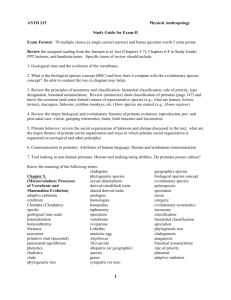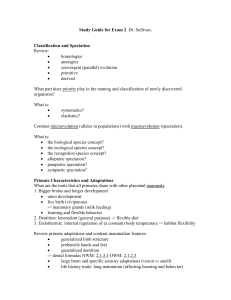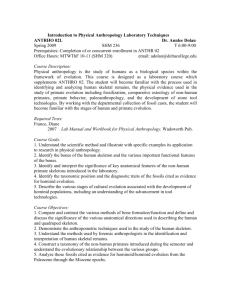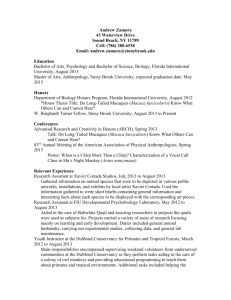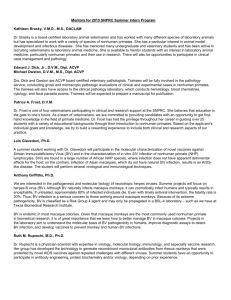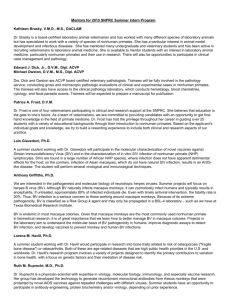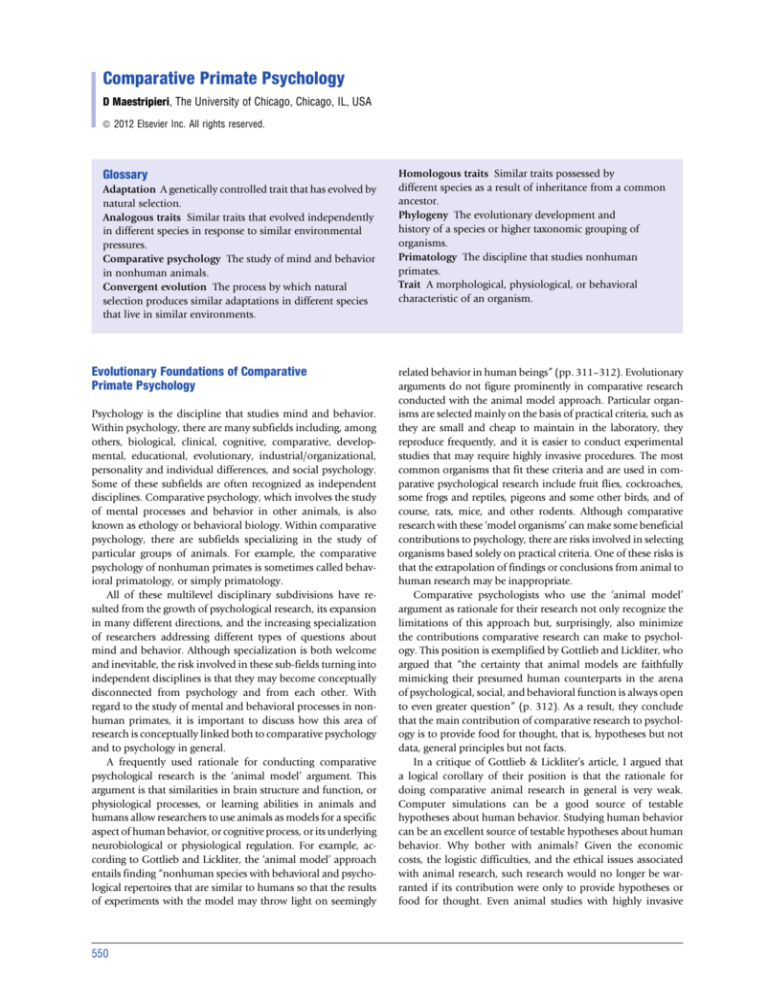
Comparative Primate Psychology
D Maestripieri, The University of Chicago, Chicago, IL, USA
ã 2012 Elsevier Inc. All rights reserved.
Glossary
Adaptation A genetically controlled trait that has evolved by
natural selection.
Analogous traits Similar traits that evolved independently
in different species in response to similar environmental
pressures.
Comparative psychology The study of mind and behavior
in nonhuman animals.
Convergent evolution The process by which natural
selection produces similar adaptations in different species
that live in similar environments.
Evolutionary Foundations of Comparative
Primate Psychology
Psychology is the discipline that studies mind and behavior.
Within psychology, there are many subfields including, among
others, biological, clinical, cognitive, comparative, developmental, educational, evolutionary, industrial/organizational,
personality and individual differences, and social psychology.
Some of these subfields are often recognized as independent
disciplines. Comparative psychology, which involves the study
of mental processes and behavior in other animals, is also
known as ethology or behavioral biology. Within comparative
psychology, there are subfields specializing in the study of
particular groups of animals. For example, the comparative
psychology of nonhuman primates is sometimes called behavioral primatology, or simply primatology.
All of these multilevel disciplinary subdivisions have resulted from the growth of psychological research, its expansion
in many different directions, and the increasing specialization
of researchers addressing different types of questions about
mind and behavior. Although specialization is both welcome
and inevitable, the risk involved in these sub-fields turning into
independent disciplines is that they may become conceptually
disconnected from psychology and from each other. With
regard to the study of mental and behavioral processes in nonhuman primates, it is important to discuss how this area of
research is conceptually linked both to comparative psychology
and to psychology in general.
A frequently used rationale for conducting comparative
psychological research is the ‘animal model’ argument. This
argument is that similarities in brain structure and function, or
physiological processes, or learning abilities in animals and
humans allow researchers to use animals as models for a specific
aspect of human behavior, or cognitive process, or its underlying
neurobiological or physiological regulation. For example, according to Gottlieb and Lickliter, the ‘animal model’ approach
entails finding “nonhuman species with behavioral and psychological repertoires that are similar to humans so that the results
of experiments with the model may throw light on seemingly
550
Homologous traits Similar traits possessed by
different species as a result of inheritance from a common
ancestor.
Phylogeny The evolutionary development and
history of a species or higher taxonomic grouping of
organisms.
Primatology The discipline that studies nonhuman
primates.
Trait A morphological, physiological, or behavioral
characteristic of an organism.
related behavior in human beings” (pp. 311–312). Evolutionary
arguments do not figure prominently in comparative research
conducted with the animal model approach. Particular organisms are selected mainly on the basis of practical criteria, such as
they are small and cheap to maintain in the laboratory, they
reproduce frequently, and it is easier to conduct experimental
studies that may require highly invasive procedures. The most
common organisms that fit these criteria and are used in comparative psychological research include fruit flies, cockroaches,
some frogs and reptiles, pigeons and some other birds, and of
course, rats, mice, and other rodents. Although comparative
research with these ‘model organisms’ can make some beneficial
contributions to psychology, there are risks involved in selecting
organisms based solely on practical criteria. One of these risks is
that the extrapolation of findings or conclusions from animal to
human research may be inappropriate.
Comparative psychologists who use the ‘animal model’
argument as rationale for their research not only recognize the
limitations of this approach but, surprisingly, also minimize
the contributions comparative research can make to psychology. This position is exemplified by Gottlieb and Lickliter, who
argued that “the certainty that animal models are faithfully
mimicking their presumed human counterparts in the arena
of psychological, social, and behavioral function is always open
to even greater question” (p. 312). As a result, they conclude
that the main contribution of comparative research to psychology is to provide food for thought, that is, hypotheses but not
data, general principles but not facts.
In a critique of Gottlieb & Lickliter’s article, I argued that
a logical corollary of their position is that the rationale for
doing comparative animal research in general is very weak.
Computer simulations can be a good source of testable
hypotheses about human behavior. Studying human behavior
can be an excellent source of testable hypotheses about human
behavior. Why bother with animals? Given the economic
costs, the logistic difficulties, and the ethical issues associated
with animal research, such research would no longer be warranted if its contribution were only to provide hypotheses or
food for thought. Even animal studies with highly invasive
Comparative Primate Psychology
experimental procedures that are impossible in humans would
be difficult to justify if their main contribution were only to
provide hypotheses. I argued instead that animal studies provide much more than food for thought, and discussed many
cases in which animal data have clear cross-species validity and
direct extrapolability to the human condition. To give just one
example, in his 1969 formulation of attachment theory, British
psychoanalyst John Bowlby did not use information from
nonhuman primate research just to develop the hypothesis
that there they might be an attachment system in humans or
some general principles about its functioning. He showed that
there were ‘formal similarities’ in the infant response to separation, the development of fear of strangers, and the use of the
mother as a secure base in monkeys and in humans. Based on
these and other similarities, he argued that the development,
regulation, and adaptive function of the attachment system are
very similar in humans and some other primates, and that this
similarity is probably due to common descent, that is, humans
and closely related primates inherited the infant attachment
system from their common ancestors. Thus, Bowlby provided a
clear example of how data from nonhuman animals, and not
just hypotheses or general principles, can be directly extrapolated to humans and how one can develop a theory of behavior
that has a strong evolutionary foundation and cross-species
validity.
Evolutionary biologist Theodosius Dobzhansky once said
“Nothing in biology makes sense except in light of evolution.”
Many evolutionary and comparative psychologists believe that
the same should be said about psychology as well. Comparative psychological research can be strongly justified on evolutionary grounds, and evolutionary arguments can also help
select the best study organisms and the research questions
that can be best addressed from a comparative perspective.
One evolutionary rationale for conducting comparative research is that similarities in behavior between animals and
humans are the result of common phylogenetic history. In
this view, certain traits are similar in animals and humans
because they were inherited from a common ancestor, that is,
they are ‘homologous.’ Studying these traits in animals helps
one elucidate the phylogenetic history of human behavior.
In general, the probability that two species have homologous
traits is higher the closer the phylogenetic relationship between
the species. Thus, human behavior is more likely to be homologous to the behavior of other primates than to the behavior of
nonprimate animals. This provides a strong evolutionary rationale for using nonhuman primates, especially primates that
are closely related to humans, in comparative psychological
research.
Another evolutionary rationale for conducting comparative
research is that similarities in behavior between animals and
humans may be the result of convergent evolution. This means
that similar traits in animals and humans evolved by natural
selection in response to similar pressures from the environment, but independently in different species. These traits are
considered ‘analogous’ and studying them can help one understand how the environment has shaped human behavior
through the action of natural selection. Similar adaptations
to the environment can occur in species that are distantly
related and, therefore, in theory, to investigate the adaptive
aspects of human behavior from a comparative perspective,
551
honeybees can be as good as models as chimpanzees are. In
reality, however, there are many constraints on the type of
adaptations to the environment that organisms can evolve
through natural selection. Therefore, similarities in genetic,
anatomical, physiological, and cognitive constraints increase
the probability that organisms will evolve similar adaptations
to the environment. Thus, human behavior is generally more
likely to be analogous to the behavior of other primates than to
the behavior of nonprimate species. This provides another
strong evolutionary rationale for using nonhuman primates
in comparative psychological research.
Studying the mind and behavior of nonhuman primates
that are closely related to man can potentially enhance the
understanding of many human mental and behavioral processes for clear evolutionary reasons. Although primatology
and psychology are sometimes considered different disciplines,
there is no conceptual reason why this should be the case. In
fact, the history of research on primate minds and behavior
illustrates that, from the very beginning, studies of primate and
human minds and behavior were closely interwoven.
History of Comparative Primate Psychology
The implications of primate behavior research for understanding human behavior were first explicitly recognized by Darwin,
who in his 1872 book on ‘The Expression of Emotions in Animals
and Man’ drew several parallels between the facial expressions
of nonhuman primates and those of human beings. However,
it was psychologists rather than evolutionary biologists who
began the systematic study of primate behavior and cognition
at the beginning of the twentieth century.
One of the first psychologists to conduct systematic primate
behavioral research was Wolfgang Köhler. As a Gestalt psychologist, Köhler was interested in cognitive processes other than
learning and was curious to see if apes could use ‘insight’ to
solve novel cognitive tasks. In a research station established at
Tenerife on the Canary Islands, Köhler conducted many elegant experiments with chimpanzees during the period 1913–
1917. Many of these experiments involved the manipulation of
the environment to obtain food rewards and the use of previously familiar objects in novel and instrumental ways. Köhler’s
research questions and some of its procedures were very innovative and some of its findings are still highly cited in contemporary research. He can certainly be considered one of the
founders of modern research on primate cognition.
In the United States, the systematic study of primate behavior was pioneered by Robert Yerkes, a Harvard-trained psychologist who established a primate research facility in Orange
Park, Florida, with the goal of making primates available to
many different kinds of scientific inquiry, most notably, psychological research. Yerkes felt that research on the behavior
and cognitive abilities of primates, and in particular the great
apes, would help answer some questions in psychology that
had historically been very difficult to address. His contributions to primate behavior research were many and ranged from
studies of spatial cognition and problem-solving to research on
social and maternal behavior.
In addition to the pioneer efforts by Köhler and Yerkes,
other early attempts to study primate behavior and cognition
552
Comparative Primate Psychology
were made in Russia, France, Cuba, and other parts of the
world. The 1920s and 1930s also saw the beginning of
attempts to teach language to chimpanzees. The first of such
attempts was made in 1930 by Kellogg and Kellogg who raised
a young chimpanzee named Gua along with their son Donald.
The Kelloggs’ experiment turned out to be a failure but it was
followed by many others, using similar or different strategies.
Along with the growing recognition that primate behavior
could be useful to understand human behavior, the years
before World War II were characterized by increasing interest
in studying primates in their natural habitat and understanding the basic principles regulating their social organization.
With World War II, research on primate behavior was interrupted for almost a decade, but in the early 1950s and especially in the 1960s, there was renewed interest in studies of
primate behavior all around the world. Japanese primatologists’ intensive and long-term studies of social behavior led to
the discovery of kinship systems and cultural traditions in
macaque societies. Primate behavior research in Japan, however, was originally conducted within the tradition of anthropology, and it is only later that such research established a
strong connection with psychological science. The 1950s also
witnessed the resumption of research with rhesus macaques on
the island of Cayo Santiago, in Puerto Rico, where an American
zoologist, Clarence Ray Carpenter, had established a colony of
these monkeys prior to the War. The availability of genealogical information on the animals and the long-term observations
of their behavior contributed, along with the work of Japanese
primatologists, to the identification of the matrilineal structure
of macaque society and the mechanisms underlying the acquisition of dominance.
As more information on primate social behavior became
available, Harvard anthropologist Sherwood Washburn developed the conviction that extant primate species could provide
important information on human origins and social evolution.
He and his graduate students pioneered field studies of primate
behavior in Africa and Asia, placing particular emphasis on
aggressive and maternal behavior. These two topics dominated
much of primate behavior research through the 1960s and
1970s. Interest in anthropology and human origins also motivated paleontologist Robert Leakey to begin long-term studies
of chimpanzees, gorillas, and orangutans, which were led by
Jane Goodall, Diane Fossey, and Birute Galdikas, respectively.
Psychologists’ interest in primate behavior rose dramatically with the resumption of research in captivity after World
War II. Harry Harlow’s research at the University of Wisconsin
played a pivotal role in this process. After making important
contributions to the study of primate learning, Harlow concentrated his efforts on elucidating the nature of infant attachment and social development in rhesus monkeys. Harlow’s
well-known experiments with surrogate mothers demonstrated
that the mother’s ability to provide contact comfort is a more
important determinant of infant attachment than her ability to
provide milk, thus providing a fatal blow to secondary-drive
theories of attachment. Because Harlow’s work touched upon
many areas of research that were very important to psychologists at that time (e.g., learning and motivation, attachment,
normal and abnormal social development, the social origin of
affective disorders), and because Harlow’s academic career
took place within psychology, during the years in which most
of his work was conducted and published, primate behavior
research was very well known among psychologists.
Although Harlow was very effective in promoting the
importance of primate behavior research in the scientific community and the general public, the person who made the most
systematic effort to conceptually integrate primatology and
psychology was probably the British ethologist Robert Hinde.
Hinde’s interest in primate research was sparked by John
Bowlby, who encouraged him to set up a colony of rhesus
monkeys in Cambridge and investigate mother–infant attachment processes. From the study of social influences on the
mother–infant relationship, the scope of Hinde’s research
was gradually broadened and elaborated into a conceptual
framework for the study of social processes, which distinguished three main levels of complexity: interactions, relationships, and social structure. Hinde made important conceptual
contributions to the science of social relationships, and for
decades was one of the most articulate proponents of the
conceptual integration between biological and psychological
approaches to the study of behavior.
Thanks to the efforts of talented and charismatic scientists
such as Harlow and Hinde and the success of field studies of
primate behavior begun in the 1960s, primatology reached a
peak in popularity in the 1960s and early 1970s. In the mid- to
late 1960s, in particular, behavioral research in the United
States thrived at the newly established Regional Primate
Research Centers, and most research proposals to study primate behavior were readily funded by federal and private agencies. In the 1960s and 1970s, a large number of articles and
books on primate behavior were published, and primate behavior research was probably well represented in all branches of
scientific psychology, including developmental, social, cognitive, and clinical. The heyday of primatology, however, did not
last long. In the early 1970s, that is, only ten years after the
establishment of the NIH-funded Regional Primate Research
Centers, there were already significant cuts to research funding.
The realization that evolutionary theory could be effectively
applied to the study of social behavior in the 1960s and 1970s
gave a great boost to primate research in the field. Although
anthropology and psychology had been the disciplines dominating primate behavior research up to the 1970s, ecology and
evolutionary biology acquired a leading role in most subsequent research. The fact that behavioral ecologists were
mostly interested in questions of adaptive function whereas
psychologists were mostly interested in questions of proximate causation or development of behavior was one of the
several factors that contributed to the growing separation
between primate behavior research and psychological science
that occurred in the 1980s and early 1990s. Another important factor was the rapid progress of biological disciplines
such as genetics, molecular biology, and neuroscience and
the growing popularity of scientific reductionism. In particular, the success of neuroscience led to the optimistic view that
many important questions about behavior would eventually
be answered by studies of brain anatomy and function, thus
rendering behavioral research unnecessary. One corollary of
this view was the belief that comparative research with primates may not be as useful as research with other species,
given the difficulty of conducting molecular work with
primates.
Comparative Primate Psychology
Despite the current weakness of primatological research, in
the last decade, some favorable conditions have emerged for
renewed cross-fertilization between primatology and psychology. The cognitive revolution that occurred in psychology in
the middle of the century was followed, a few decades later, by
a similar cognitive revolution in the field of animal behavior,
and primate behavior in particular. Thanks to the efforts of
pioneers such as Donald Griffin and Gordon Gallup, once it
became scientifically acceptable to ask whether animals have
a sense of self and understand other individuals as having a
mental life of their own, the field of primate cognition
boomed. It became apparent that many of the questions traditionally addressed by cognitive psychologists could also be
addressed, with similar or new experimental procedures, in
primates as well. Therefore, research on primate cognition
shifted from the study of learned behavior to the study of
mental representations of the self and of the physical and
social environment. Today, cognition is the branch of scientific
psychology in which primate behavior research is best known
and represented. Interestingly, and in line with the notion that
comparative psychological research should have strong evolutionary foundations, a further impetus for research on primate
cognition has been provided by the framing of cognitive investigations within ecology and evolutionary biology, which has
led to a new understanding of primate cognitive adaptations,
their ecological significance, and evolutionary origins.
Comparative Primate Cognition
Primate cognitive adaptations can be conceptualized as complex “behavioral adaptations in which perceptual and behavioral processes are (1) organized flexibly, with the individual
organism making decisions among possible courses of action
based on an assessment of the current situation in relation to
its current goal; and (2) involve some kind of mental representation that goes beyond the information given to direct perception.” Cognitive adaptations, and their underlying neural
substrates, evolve by natural selection in response to recurrent
problems posed by the physical, ecological, or social environment. Within this framework, the question can be raised as to
whether the primate order as a whole exhibits cognitive adaptations that are different from those of other animals, and
whether primates that are phylogenetically closest to humans
show evidence of cognitive specializations similar to those of
the human species.
The study of primate cognitive adaptations has involved
many aspects of physical and social cognition. Primate research in the domain of physical cognition has addressed how
monkeys and apes acquire information about the physical
space in which they live and the inanimate objects in it, how
information is mentally represented and processed, and how it
is retrieved and used to make decisions. Free-ranging primates
form spatial maps that represent the environment in which
they live and use them to make travel decisions as they search
for food within their home range. In the laboratory, primates
exhibit knowledge of movements of objects through space and
understanding of object permanence, that is, the notion that
objects continue to exist and maintain their features and
properties if they have been moved or hidden from view.
553
For example, primates search for hidden objects and can
solve tasks that require mental rotation of object orientation.
Though primates are proficient at these tasks, there is no evidence that primates have greater understanding of space and
objects relative to other mammals, nor is there evidence of
significant differences among primate species (e.g., between
monkeys and apes).
Other research in the domain of physical cognition has
involved object manipulation tasks, in which objects are used
in relation to other objects, and which require an understanding of causality (e.g., the relation between the use of the tool
and the goal to be accomplished with it). Many species of
primates, and especially capuchin monkeys and the great
apes, are proficient tool users and also show some evidence
of understanding of causality. However, primates’ tool using
skills have been matched or even surpassed by those of some
corvid birds. Discrimination learning studies have addressed
whether primates learn to discriminate particular features
of objects and assign these objects to categories on the basis
of similarities and differences in these features. These studies
have shown that primates can not only discriminate and categorize objects but also understand complex rules underlying
categorization, for example, the notion that categories of
objects can be formed on rules such as identity, oddity, sameness, or difference. Similar to birds and other mammals (e.g.,
laboratory rats), primates also possess the ability to make
accurate estimates of small quantities of items as well as the
ability to solve simple tasks involving quantity conservation or
summation. The exact perceptual or conceptual mechanisms
underlying these skills remain unclear.
Taken together, studies of primate physical cognition have
shown that monkeys and apes possess the ability to form
mental representations of their space and objects, including
hidden ones, but show little evidence of greater learning skills
or greater understanding of the physical world and its properties than other vertebrate animals do. The strongest evidence
for a potentially unique primate cognitive specialization in the
realm of physical cognition involves the use of tools and the
understanding of relational properties of objects including
causality. This is particularly strong in large-brained primate
species that face strong ecological pressures for complex food
processing such as capuchin monkeys, and for all species of
great apes.
In the domain of social cognition, early studies of primates’
ability to recognize themselves in a mirror were driven by
the hypotheses that mirror self-recognition indicates selfawareness and that knowledge of the self forms the basis for
theory of mind. On the mark test of self-recognition, primates
as a whole perform better than other animals, and apes perform better than monkeys. However, the notion that learning
how to use a mirror to inspect inaccessible aspects of one’s
body necessarily entails possessing a concept of self has been
questioned. Experimental evidence for theory of mind skills
including intentionality or attribution of knowledge or ignorance to others is scarce but stronger for chimpanzees and
other apes than for monkeys. Theory of mind is clearly a
unique primate cognitive specialization but could be limited
to the human species, and possibly the great apes. Complex
forms of social learning involving emulation, imitation, or
teaching have also been documented mainly in great apes,
554
Comparative Primate Psychology
where they are believed to form the basis for the origin and
spread of behavioral traditions that may approximate elementary forms of human culture. The question of whether or not
culture can be considered a cognitive specialization unique to
humans or shared by other primates rests on how culture is
defined and what operational criteria are used for its identification across species.
While the question of whether nonhuman primates have the
ability to think about other individuals’ mental states remains
unanswered, it is well recognized that they excel at the task of
observing other individuals’ behavior, remembering past interactions, and making predictions about the future. Primates form
complex social relationships with others and have knowledge
and memory not only of their own relationships, but also of
relationships between other individuals. Studies investigating
this aspect of social cognition have assessed primates’ ability
to recognize kinship, dominance rank relationships, or friendships between individuals that reside in their social group.
Knowledge of social relationships is used in complex cooperative
and competitive strategies involving exchange of favors, alliance
formation, opportunistic exploitation of social situations, and
manipulation of other individuals with deceitful tactics.
Complex social strategies in group-living monkeys and
apes invariably entail the exchange of vocal or visual signals
between individuals. Communication can therefore provide a
window into the primate social mind. Specifically, many
aspects of communication can provide insights into social
cognition, including the role of social learning in the developmental acquisition of signal production, comprehension, and
usage; the extent to which signals are under volitional control
and can be used flexibly; the complexity in the structure of
signals; the information content or meaning of signals; the
extent to which signals are combined with other signals within
the same modality or across different modalities to accomplish
different functions; the extent to which combinations of signals exhibit properties of human languages such as grammar or
syntax; and the extent to which the production of signals is
modified in relation to the presence of particular individuals
(audience effects), their attentional states or current behavior,
and possibly also their mental states.
The search for cognitive complexity in primate communication has often focused on vocalizations, in part because of
possible direct parallels between monkey vocalizations and
human speech. For example, great emphasis has been placed
on the finding that vervet monkeys and other primates possess
different alarm calls for aerial and terrestrial predators, and are
therefore capable of semantic communication. It is now recognized, however, that this ability is shared by a number of birds
and other mammals. Food calls have also been given as examples of referential signals, as according to some researchers,
they convey information about the type, quantity, and location
of food to other conspecifics. It is unlikely, however, that
primate vocalizations about predators or food require a higher
degree of cognitive complexity than similar vocalizations used
by other mammals, birds, and other animals. This is because
the problems faced by most primates during foraging or escaping predators are simply no different in complexity from those
faced by most other animal species. Therefore, it is difficult to
argue that these activities posed a special pressure to evolve
higher cognitive or communicative abilities in primates.
The agonistic screams of macaques appear to elicit different
responses from other group members in relation to characteristics of opponents such as their dominance rank, and representational signaling in the context of recruitment of agonistic
support is an ability that might have been strongly selected for
in the social environment of group-living primates. Vocalizations that are emitted in order to coordinate the behavior of
group members during travel or to facilitate affiliative and
bonding interactions are an even more promising area of
investigation because, unlike antipredator calls and recruitment screams, these signals are not obviously associated with
states of high arousal. Contact vocalizations that facilitate
coordination of group movements and close-range interactions are particularly well developed in arboreal species such
as New World monkeys. The complexity of vocal structure and
vocal sequences in New World monkeys, however, is likely to
be the result of the pressures of arboreal life rather than those
of social variables. Moreover, the referential nature of agonistic
screams, grunts, or other short-range contact calls has been
called into question even for the Old World monkeys and apes.
Regardless of how primate calls are interpreted, there is
little or no evidence that primates as a whole show complex
cognitive specializations in their vocal communication abilities relative to other animals. Moreover, there is no trend
toward increasing complexity in the structure, function, and
use of vocal signals from the prosimians to the New World
monkeys, the Old World monkeys, and the great apes, suggesting that the evolutionary increase in brain size that occurred in
the Cercopithecoids and the ape lineage was not associated
with increasing complexity in vocal exchanges or their cognitive substrates. Such an evolutionary trend, however, is observable in the use of nonvocal signals. In the Old World monkeys
and in the great apes, there is a clear increase in the role played
by facial expressions (associated with the development of complex facial musculature) relative to vocalizations. Moreover, in
the great apes, there is an involvement of the arms and hands
in making social gestures to a degree that is not observed in
other nonhuman primates or other animals.
Although there is no good evidence that manual gestures
are socially learned from others, the flexibility with which great
apes use gestures in different contexts likely requires considerable developmental learning and experience. If gestures develop through a process of ontogenetic ritualization, it would
require many exposures to and opportunities to perform a
particular action before it becomes a gesture. If the forms of
gestures are largely innate, then a period of learning when
different gestures are likely to be effective (e.g., visual only
when visible) would be required. Thus, it is possible that primates, and especially great apes, have evolved cognitive specializations to attend to and learn to use social variables (such as
identity, visual attention, and dominance) during communication, and particularly during gesture.
The importance of development in shaping primate communication has been investigated in only a limited number of
studies, and almost all of them have focused on vocal communication. Additionally, little is known about the relationships
between cognitive abilities such as understanding visual attention, gaze following, and individual recognition and the structure and use of communication systems in nonhuman
primates. In humans, language develops alongside a whole
Comparative Primate Psychology
range of cognitive abilities – building upon some and providing
the foundation for others. The relationship between the emergence of language and other cognitive abilities is well studied in
humans: similar work is needed in nonhuman primates. Comparative developmental studies are needed to understand
whether and how development of one ability (e.g., understanding social hierarchies) affects or is affected by the development
of communicative behaviors (e.g., using different strategies
when communicating with a dominant vs. a subordinate individual). Within this framework of research, developmental
studies of gesture acquisition and experimental studies of gesture use have the potential to shed new light on the socialcognitive specializations of great apes and, more generally,
provide a window into the nonhuman primate mind.
See also: Evolutionary Psychology; Primate Cognition.
Further Reading
Blum D (2002) Love at Goon Park: Harry Harlow and the Science of Affection.
Cambridge, MA: Perseus.
555
Call J and Tomasello M (eds.) (2007) The Gestural Communication of Apes and
Monkeys. Mahwah, NJ: Lawrence Erlbaum.
Cheney DL and Seyfarth RM (2007) Baboon Metaphysics: The Evolution of a Social
Mind. Chicago: The University of Chicago Press.
Gallup GG (1985) Do minds exist in species other than our own? Neuroscience and
Biobehavioral Reviews 9: 631–641.
Gottlieb G and Lickliter R (2004) The various roles of animal models in understanding
human development. Social Development 13: 311–325.
Hauser MD (1996) The Evolution of Communication. Cambridge, MA: MIT Press.
Hinde RA (1987) Individuals, Relationship’s and Culture. Links Between Ethology
and the Social Sciences. Cambridge: Cambridge University Press.
Maestripieri D (ed.) (2003) Primate Psychology. Cambridge, MA: Harvard
University Press.
Maestripieri D (2003a) The past, present, and future of primate psychology. In:
Maestripieri D (ed.) Primate Psychology, pp. 1–16. Cambridge, MA: Harvard
University Press.
Maestripieri D (2003b) Attachment. In: Maestripieri D (ed.) Primate Psychology,
pp. 108–143. Cambridge, MA: Harvard University Press.
Maestripieri D (2005) On the importance of comparative research for the understanding
of human behavior and development: A reply to Gottlieb & Lickliter (2004).
Social Development 14: 181–186.
Maestripieri D (2007) Macachiavellian Intelligence: How Rhesus Macaques and
Humans Have Conquered the World. Chicago: The University of Chicago Press.
Matsuzawa T (2001) Primate Origins of Human Cognition and Behavior.
Berlin: Springer.
Rendall D and Di Fiore A (2007) Homoplasy, homology, and the perceived special
status of behavior in evolution. Journal of Human Evolution 52: 504–521.
Tomasello M and Call J (1997) Primate Cognition. Oxford: Oxford University Press.

